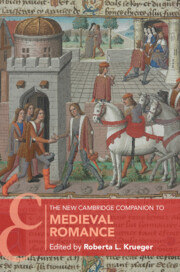Book contents
- The New Cambridge Companion to Medieval Romance
- The New Cambridge Companion to Medieval Romance
- Copyright page
- Contents
- Figures
- Contributors
- Acknowledgments
- Chronology
- Introduction
- 1 “For Love and For Lovers”
- 2 The Manuscript Contexts of Medieval Romance
- 3 Matters of Form
- 4 Authors, Narrators, and Their Stories in Old French Romance
- 5 Arthurian Transformations
- 6 Romance and the Medieval Mediterranean
- 7 The Crusading Romance in Britain
- 8 “Making Race” in Medieval Romance
- 9 The Construction and Interrogation of Gender in Old French Romance
- 10 Emotions as the Language of Romance
- 11 Medieval Iberian Romance
- 12 Medieval and Early Modern Italian Romance
- 13 German Medieval Romance
- 14 The Ends of Romance in Chaucer and Malory
- 15 French Romance in the Late Middle Ages and the Renaissance
- 16 Romance in Historical Context
- 17 Romance in Twentieth- and Twenty-First-Century Popular Culture
- Bibliography of Editions and Translations
- Index
- Cambridge Companions To …
- References
12 - Medieval and Early Modern Italian Romance
Published online by Cambridge University Press: 11 May 2023
- The New Cambridge Companion to Medieval Romance
- The New Cambridge Companion to Medieval Romance
- Copyright page
- Contents
- Figures
- Contributors
- Acknowledgments
- Chronology
- Introduction
- 1 “For Love and For Lovers”
- 2 The Manuscript Contexts of Medieval Romance
- 3 Matters of Form
- 4 Authors, Narrators, and Their Stories in Old French Romance
- 5 Arthurian Transformations
- 6 Romance and the Medieval Mediterranean
- 7 The Crusading Romance in Britain
- 8 “Making Race” in Medieval Romance
- 9 The Construction and Interrogation of Gender in Old French Romance
- 10 Emotions as the Language of Romance
- 11 Medieval Iberian Romance
- 12 Medieval and Early Modern Italian Romance
- 13 German Medieval Romance
- 14 The Ends of Romance in Chaucer and Malory
- 15 French Romance in the Late Middle Ages and the Renaissance
- 16 Romance in Historical Context
- 17 Romance in Twentieth- and Twenty-First-Century Popular Culture
- Bibliography of Editions and Translations
- Index
- Cambridge Companions To …
- References
Summary
This chapter examines the reception of romance in medieval Italy, focusing on the way in which Italian writers engaged with the form and content of the genre. It examines different modes of adaptation through the lens of three texts from different Italian-speaking communities and time periods. Firstly, the Franco-Venetian Prophecies de Merlin demonstrates the hybrid character of Italian romance, which combines French and Italian language and perspectives -- in this case, to incorporate Italian interests in political prophecy into the Arthurian story. The Tuscan Tavola Ritonda characterizes Italian-vernacular adaptations of French prose cycles, combining ideals of chivalric heroism with civic values to resignify Tristan’s status as the perfect knight. Finally, the late medieval Ferrarese L’Inamoramento de Orlando by Matteo Maria Boiardo draws on the Italian cantari in its incorporation of romance themes and forms alongside chanson de geste. Italian medieval romance emerges as a malleable and porous genre that is always in dialogue with other genres and cultural perspectives.
- Type
- Chapter
- Information
- The New Cambridge Companion to Medieval Romance , pp. 180 - 193Publisher: Cambridge University PressPrint publication year: 2023

